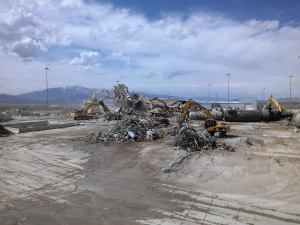 Envirocon recently completed the demolition of The Tooele Chemical Agent Disposal Facility (TOCDF), safely, within budget, and one month ahead of schedule. The TOCDF was a U.S. Army facility located at Tooele Army Depot (TEAD) in Tooele County, Utah. It was constructed in the early 1990s and was used for dismantling chemical weapons under the Chemical Weapons Convention. VX, Sarin, and mustard gas were processed at this facility. URS/EG&G DMI was the prime contractor to the Army tasked with the disposal of the large number of WWII-era chemical weapons being stored at the Deseret Chemical Depot. URS/EG&G DMI operated several incinerators at the TOCDF which destroyed the chemical agents and thermally decontaminated the metal bodies which contained the chemical agents. Disposal activities began in 1996 and were completed in January of 2012.
Envirocon recently completed the demolition of The Tooele Chemical Agent Disposal Facility (TOCDF), safely, within budget, and one month ahead of schedule. The TOCDF was a U.S. Army facility located at Tooele Army Depot (TEAD) in Tooele County, Utah. It was constructed in the early 1990s and was used for dismantling chemical weapons under the Chemical Weapons Convention. VX, Sarin, and mustard gas were processed at this facility. URS/EG&G DMI was the prime contractor to the Army tasked with the disposal of the large number of WWII-era chemical weapons being stored at the Deseret Chemical Depot. URS/EG&G DMI operated several incinerators at the TOCDF which destroyed the chemical agents and thermally decontaminated the metal bodies which contained the chemical agents. Disposal activities began in 1996 and were completed in January of 2012.
URS/EG&G DMI was also responsible for the RCRA closure of the TOCDF facilities including demolition and disposal of all facilities not earmarked for TEAD retention. After a competitive bid process Envirocon was awarded the TOCDF Demolition project in August of 2013 to support the RCRA closure.
In order to effectively and safely perform this work, Envirocon developed comprehensive site-specific plans to cover every aspect of the work. Envirocon worked very closely with the URS/EG&G team to obtain a comprehensive understanding of their goals for the project and develop the Project Management Plan (PMP). The PMP served as an overall Work Control Plan and included; a Site-Specific Health and Safety Plan; Quality Control Plan; Demolition Work Plan; Waste Management Plan; Storm Water Management Plan; Traffic Control Plan; and a Subcontracting Plan. Envirocon prepared and presented the PMP to the Plant Operations Review Committee (PORC) for approval at the end of October 2013 and received final approval and notice to proceed with the demolition work.
Envirocon began demolition activities in January 2014. The demolition project was broken down into 17 different zones, spread over three areas across the depot. The project had a number of key milestone dates which had to be attained in order for the project to be considered successful.
The TOCDF was a complex 32 building facility consisting of heavily reinforced, blast resistant steel, and concrete structures. Envirocon mobilized a 30-person team to the site and a fleet of owned equipment including eight excavators equipped with grapple buckets, hydraulic shears, hydraulic hammers, universal processors, a magnet, and a powered screen bucket. In general, Envirocon used a top-down approach to demolish the facility utilizing excavators with demolition attachments. Some of the more challenging structures were the approximately 90-foot tall Pollution Abatement System (PAS) and the 40-foot tall concrete blast resistant structure associated with the Munitions Demilitarization Building (MDB).
On the PAS, Envirocon designed a Felling Plan to drop the 90-foot tall section of the structure along with contained pipes and vessels using a PC400 excavator with shear in lieu of using an ultra-high reach shear as required by the contract documents. This value engineered solution resulted in a cost savings to the owner and greatly reduced the risk to workers and equipment.
The demolition of the blast-resistant structure within the MDB posed a significant challenge. This concrete structure was reinforced with #18 rebar and 1-inch thick steel plating. This 40-foot high structure was brought down using a PC800 with UP90 attachment assisted by a PC400 with a 16,000 lb hydraulic hammer.
After the structures were razed, excavators equipped with hydraulic hammers (12,000 to 16,000 lbs) were used to break up and remove slabs, foundations to 1-foot below grade, pits, and sumps. Upon completion, the area was backfilled with imported fill materials, graded to allow drainage, and seeded.
Due to the nature of this facility and the type of contaminants, reuse and salvage were prohibited for most of the debris. Envirocon sized, loaded, and transported over 36,900 tons of demolition debris for off-site disposal as F999 waste. However, Envirocon was allowed to sort demolition debris into recyclable and disposable waste streams from designated areas and was able to recycle approximately 3,700 tons of ferrous and non-ferrous metals.
Envirocon safely completed the TOCDF demolition project in July 2014, approximately one month ahead of schedule.